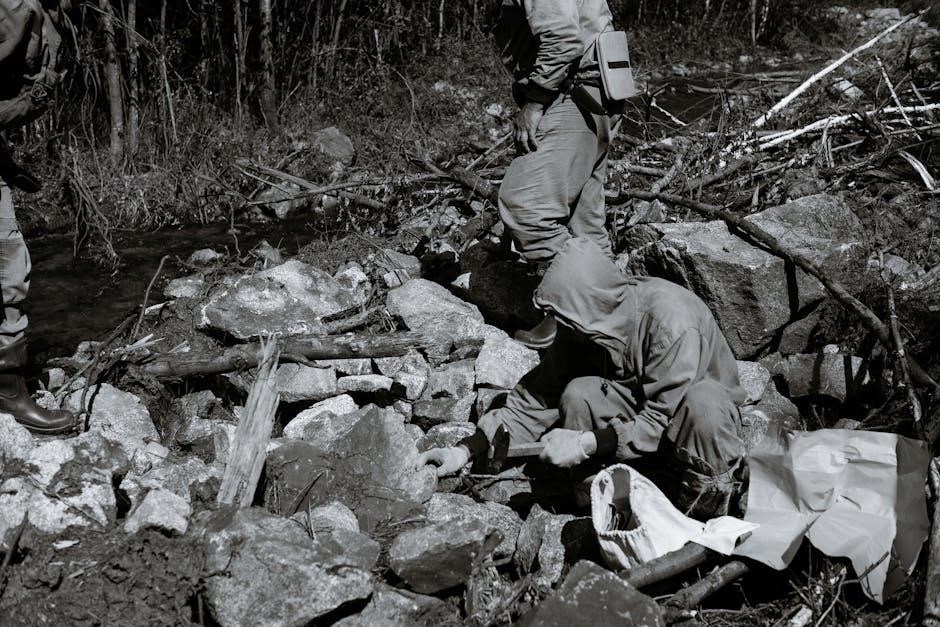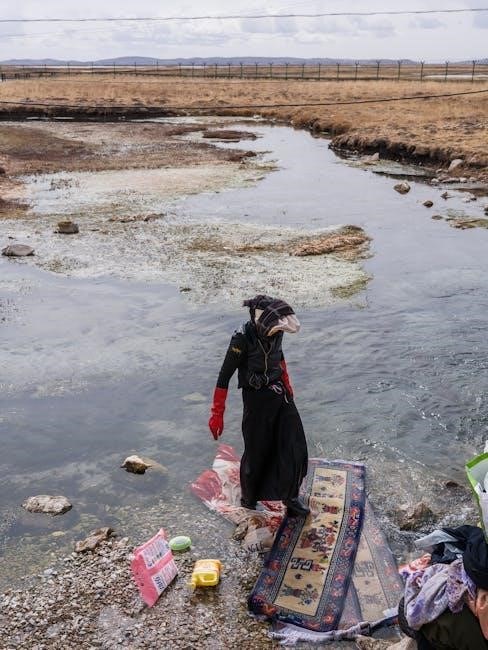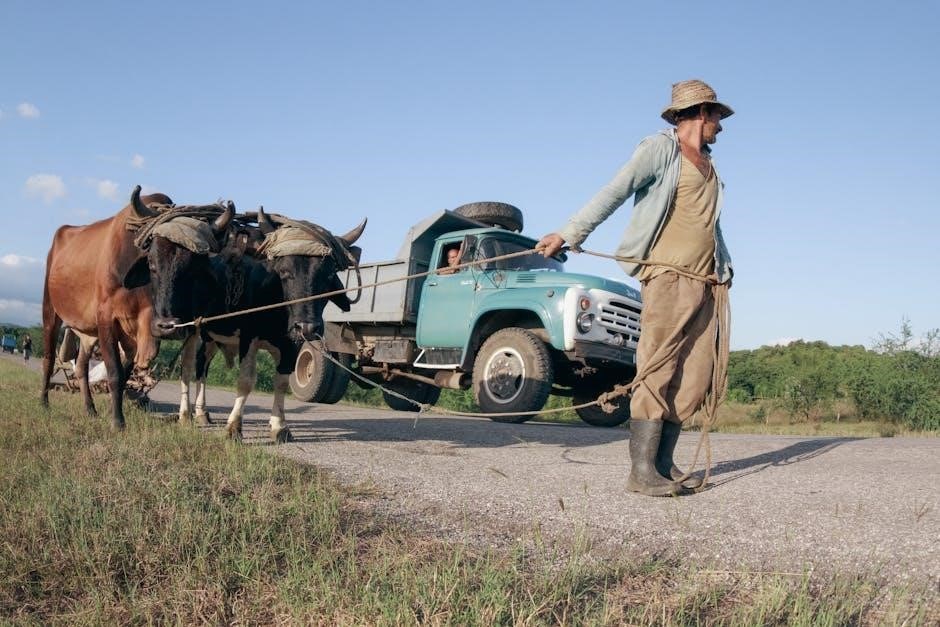The U.S. Army Survival Manual (FM 21-76) is a comprehensive guide designed to equip soldiers and civilians with essential skills to survive in extreme environments. It covers topics like finding food‚ building shelter‚ and navigating without modern tools‚ making it a must-have resource for outdoor enthusiasts and survivalists. The manual emphasizes self-reliance and practical techniques‚ ensuring preparedness in any situation.
1.1 Overview of the Manual’s Purpose and Scope
The U.S. Army Survival Manual (FM 21-76) serves as a detailed guide for surviving in diverse and hostile environments. Its primary purpose is to provide soldiers with the knowledge and skills necessary to stay alive‚ regardless of the climate or terrain. The manual covers a wide range of topics‚ including finding and purifying water‚ procuring food‚ building shelter‚ and navigating without modern tools. It also addresses psychological aspects of survival‚ first aid‚ and handling wildlife. Designed for military personnel‚ the manual has become a valuable resource for civilians‚ outdoor enthusiasts‚ and survivalists. Its scope ensures preparedness for any survival situation‚ emphasizing self-reliance and practical techniques.
1.2 Importance of Survival Skills in Extreme Environments
Survival skills are crucial for individuals facing extreme environments‚ such as arctic‚ desert‚ or jungle conditions. The U.S. Army Survival Manual (FM 21-76) emphasizes that these skills are not just for military personnel but also for anyone venturing into remote or hostile areas. Knowing how to find water‚ build shelter‚ and signal for help can mean the difference between life and death. The manual underscores the importance of mental preparedness‚ as survival often depends on maintaining a positive mindset. By mastering these skills‚ individuals can adapt to unforeseen challenges‚ ensuring their safety and well-being in the most demanding situations. This knowledge is invaluable for outdoor enthusiasts‚ adventurers‚ and those seeking to enhance their self-reliance capabilities.

History and Development of FM 21-76
The U.S. Army Survival Manual (FM 21-76) was first published in 1970‚ with significant updates in 1986 and 1992. It transitioned to FM 21-76-1 in 1999 and later to FM 3-05.70‚ reflecting evolving survival techniques and technologies. This manual has become a cornerstone of survival education‚ adapting to modern challenges while maintaining its core principles of self-reliance and adaptability.
2.1 Origins and Evolution of the Manual
The U.S. Army Survival Manual (FM 21-76) was first published in 1970‚ providing soldiers with critical survival skills for diverse environments. Over the years‚ it underwent significant updates‚ with notable revisions in 1986 and 1992. In 1999‚ it transitioned to FM 21-76-1‚ incorporating modern survival techniques. The manual later evolved into FM 3-05.70‚ reflecting advancements in technology and survival strategies. Its development was driven by the need to adapt to changing combat scenarios and environmental challenges‚ ensuring soldiers were equipped with practical‚ life-saving knowledge. The manual’s evolution highlights the U.S; Army’s commitment to improving survival capabilities‚ making it a trusted resource for both military and civilian use.
2.2 Key Updates and Revisions Over the Years
The U.S. Army Survival Manual (FM 21-76) has undergone several revisions to reflect evolving survival needs. The 1986 update expanded on wilderness survival techniques‚ while the 1992 version included new strategies for arctic and desert environments. In 1999‚ the manual was renumbered as FM 21-76-1‚ incorporating modern survival methods and technologies. The latest version‚ FM 3-05.70‚ integrates advanced techniques for urban survival and counterterrorism scenarios. Each revision has enhanced the manual’s relevance‚ ensuring it remains a vital resource for soldiers and civilians alike. These updates demonstrate the U.S. Army’s commitment to adapting survival training to meet contemporary challenges.
Core Survival Skills Covered in FM 21-76
The manual provides essential techniques for survival‚ including finding and purifying water‚ procuring food‚ building shelter‚ navigating without tools‚ signaling for help‚ and basic first aid.

3.1 Finding and Purifying Water Sources
Locating and purifying water is critical for survival. The manual teaches methods to identify water sources‚ such as streams‚ ponds‚ and underground water. It also covers techniques like transpiration bags to extract water from plants. Purification methods include boiling‚ sand filtration‚ and solar disinfection. These skills ensure safe drinking water‚ preventing dehydration and waterborne illnesses. The guide emphasizes the importance of water conservation and rationing in arid environments. Proper water management is essential for sustaining life in extreme conditions‚ making this section a cornerstone of the manual’s survival strategies.
3.2 Procuring Food in the Wilderness
The manual provides detailed guidance on foraging for edible plants and hunting small and large game. It emphasizes the importance of identifying plants safely to avoid poisoning. Techniques for constructing traps and snares are included‚ along with methods for fishing and catching insects. The guide also covers the preparation of wild game‚ ensuring food is safe to eat. Additionally‚ it advises on rationing food supplies and maintaining energy levels. These strategies help individuals sustain themselves in the wilderness‚ making food procurement a vital survival skill. The manual’s practical advice ensures that anyone can find and prepare food effectively‚ even in the most challenging environments.
3.3 Building Shelter and Protection from the Elements
Building shelter is crucial for survival‚ as it protects from harsh weather conditions. The manual details how to construct shelters using natural materials like leaves‚ branches‚ and snow. It covers various types‚ such as lean-tos‚ debris huts‚ and snow shelters‚ tailored to different environments. Instructions include how to create insulation and maintain body heat. The guide also emphasizes the importance of protecting oneself from rain‚ wind‚ and extreme cold. By following these techniques‚ individuals can create effective shelters that safeguard against the elements‚ ensuring safety and comfort in wilderness situations. These methods are essential for conserving energy and preventing hypothermia‚ making shelter-building a critical survival skill.
3.4 Navigation Techniques Without Modern Tools
The manual teaches navigation using natural signs and celestial bodies. Techniques include using the sun’s position‚ stars like the North Star‚ and shadows to determine direction. It also covers creating a shadow stick to estimate time and direction. Natural landmarks‚ such as rivers and mountain ranges‚ are highlighted as navigational aids. The guide emphasizes observing vegetation patterns‚ as trees often lean away from prevailing winds. Additionally‚ it explains how to use a watch to create a makeshift compass. These methods ensure individuals can navigate effectively without modern tools‚ relying on observation and basic equipment. Mastering these skills is vital for staying on course in remote or survival situations.

3.5 Signaling for Help and Rescue
The manual provides detailed methods for signaling help‚ ensuring visibility and audibility to rescuers. Techniques include creating smoke signals during the day and building fires at night. It emphasizes using mirrors or shiny objects to reflect sunlight toward aircraft or distant observers. The guide also covers constructing ground signals‚ such as arranging rocks or logs to form “HELP” or “SOS.” Additionally‚ it advises using whistles to signal distress‚ as the sound carries farther than shouting. The manual stresses the importance of staying visible and using repetitive patterns to attract attention. These methods are crucial for increasing the chances of rescue in remote or survival situations. Proper signaling can mean the difference between being found quickly and enduring prolonged isolation.

3.6 First Aid and Wound Management
The manual provides critical guidance on first aid and wound management‚ essential for survival in extreme conditions. It outlines steps for assessing injuries‚ cleaning wounds‚ and controlling bleeding using tourniquets or direct pressure. Emphasis is placed on preventing infection through proper wound care and the use of available resources. The guide also covers basic pain management and splinting techniques for fractures. These methods are designed to stabilize patients until professional medical help is available. By addressing immediate health concerns‚ the manual helps individuals maintain their physical condition‚ which is vital for survival. Effective wound management and first aid are cornerstone skills for enduring hostile environments.

Mental and Physical Health in Survival Situations
The manual emphasizes maintaining mental resilience and physical stamina‚ crucial for survival. It provides techniques to manage stress‚ stay positive‚ and conserve energy in extreme conditions.
4.1 Psychological Aspects of Survival
The psychological aspects of survival are crucial for enduring extreme conditions. The manual highlights the importance of maintaining a positive mindset‚ managing stress‚ and staying focused on survival goals. It emphasizes techniques to prevent panic‚ build confidence‚ and foster resilience. Mental discipline is stressed as key to overcoming fear and uncertainty. The manual also discusses the role of teamwork and leadership in group survival situations‚ promoting unity and shared purpose. By addressing these psychological elements‚ individuals can better cope with the mental challenges of survival‚ ensuring they remain motivated and capable of executing essential tasks effectively.

4.2 Maintaining Physical Health in Extreme Conditions

Maintaining physical health is vital for survival in extreme environments. The manual emphasizes the importance of staying hydrated‚ with techniques for finding and purifying water. Proper nutrition is also stressed‚ including methods for procuring and preparing food safely. Shelter construction is highlighted to protect against harsh weather conditions‚ preventing hypothermia and heatstroke. The manual also covers injury prevention and management‚ with first aid techniques to treat wounds and fractures. Physical health is closely tied to survival‚ and the manual provides practical advice to ensure individuals remain robust and capable of enduring challenging situations. These strategies are essential for sustaining life and energy in austere conditions.
Handling Wildlife and Combat Situations
The manual provides critical guidance on dealing with dangerous animals and basic combat techniques‚ ensuring survival in hostile environments through effective self-defense strategies and situational awareness.

5.1 Dealing with Dangerous Animals
The U.S. Army Survival Manual (FM 21-76) provides detailed strategies for encountering dangerous animals‚ emphasizing prevention and awareness. It covers identification of venomous snakes‚ spiders‚ and predatory wildlife‚ offering practical tips to avoid attacks. The manual advises wearing protective clothing‚ using insect repellents‚ and staying alert in high-risk areas. In case of an encounter‚ it recommends staying calm‚ maintaining distance‚ and using defensive techniques. For bites or stings‚ it outlines first aid measures to minimize harm. These guidelines ensure individuals are prepared to handle wildlife threats effectively‚ whether in tropical jungles or arid deserts‚ enhancing their chances of survival in hostile environments.
5.2 Basic Combat and Self-Defense Techniques
The U.S. Army Survival Manual (FM 21-76) includes essential combat and self-defense strategies for survival situations. It emphasizes situational awareness‚ proper stance‚ and the use of available tools or weapons. The manual teaches hand-to-hand combat techniques‚ targeting vulnerable areas to neutralize threats. It also covers disarming opponents and using environment to gain advantage. These skills are designed to help individuals protect themselves in hostile scenarios‚ ensuring survival until rescue or escape. The techniques are practical and adaptable‚ making them invaluable for both military personnel and civilians facing life-threatening situations in extreme environments. Mastery of these methods enhances confidence and increases chances of survival.

The Evolution of FM 21-76
The manual has undergone significant updates‚ transitioning to FM 21-76-1 and integrating modern survival techniques and technologies. These revisions ensure relevance in changing operational environments and threats.
6.1 Transition to FM 21-76-1 and Beyond
The U.S. Army Survival Manual evolved significantly with the release of FM 21-76-1 in June 1999‚ incorporating updated survival techniques and modern technologies. This revision reflected the changing nature of military operations and environmental challenges. The manual was later renumbered to FM 3-05.70 under the updated U.S. Military Field Manual numbering system‚ ensuring alignment with contemporary military standards. These updates expanded the scope to include urban survival‚ counterterrorism‚ and chemical‚ biological‚ radiological‚ and nuclear (CBRN) threat responses. The transition to FM 21-76-1 and beyond underscores the Army’s commitment to providing relevant‚ practical guidance for soldiers and civilians in diverse survival scenarios. This evolution ensures the manual remains a critical resource for survival preparedness.
6.2 Integration of New Survival Techniques and Technologies
The U.S. Army Survival Manual (FM 21-76) has incorporated cutting-edge survival techniques and technologies to address modern challenges. Updates include advanced water purification methods‚ improved shelter construction‚ and enhanced navigation tools like GPS. The integration of lightweight‚ durable materials and energy-efficient equipment reflects the need for practicality in extreme conditions. Additionally‚ the manual now covers urban survival‚ counterterrorism tactics‚ and responses to chemical‚ biological‚ radiological‚ and nuclear (CBRN) threats. These advancements ensure the manual remains relevant in a rapidly changing world‚ providing soldiers and civilians with the latest strategies to survive and thrive in hostile environments. This integration underscores the Army’s commitment to adaptability and innovation in survival training.
The Impact of FM 21-76 on Civilian Survival Training
The FM 21-76 has significantly influenced civilian survival training‚ becoming a standard reference for outdoor enthusiasts and shaping modern survival literature and courses worldwide.
7.1 Adoption by Outdoor Enthusiasts and Survivalists
The FM 21-76 has become a cornerstone for outdoor enthusiasts and survivalists‚ offering practical‚ military-tested strategies for wilderness survival. Its detailed guidance on finding food‚ purifying water‚ and building shelter resonates with hikers‚ campers‚ and adventurers seeking reliable techniques. Many survivalists appreciate its emphasis on self-reliance and adaptability‚ making it a trusted resource beyond military circles. The manual’s clear‚ straightforward language and user-friendly illustrations ensure accessibility for all skill levels. Its popularity has led to widespread adoption‚ with many integrating its principles into their survival kits and training regimens. As a result‚ FM 21-76 has transcended its military origins‚ becoming an essential tool for civilians preparing for extreme situations.
7.2 Influence on Modern Survival Literature and Courses
The FM 21-76 has significantly influenced modern survival literature and training programs‚ setting a benchmark for comprehensive survival education. Many authors and instructors draw inspiration from its structured approach‚ incorporating its techniques into their own materials. Survival courses worldwide often reference the manual’s methods for water purification‚ shelter construction‚ and navigation. Its clear‚ practical advice has made it a foundational text for both military and civilian survival training. The manual’s emphasis on mental preparedness and adaptability has also shaped the curriculum of wilderness survival schools. As a result‚ FM 21-76 continues to inspire new generations of survival educators and enthusiasts‚ ensuring its legacy endures in the field of survival training.
Availability and Distribution of FM 21-76
The FM 21-76 is widely available in both official publications and digital formats. It can be downloaded as a free PDF or purchased as a reprint. Digital versions are accessible through platforms like Google Play Books‚ ensuring broad accessibility for civilians and outdoor enthusiasts.
8.1 Official Publications and Reprints
The FM 21-76 U.S. Army Survival Manual is officially published by the Department of the Army and widely distributed. It is available as a free PDF download from authorized sources like the U.S. Army’s official website and platforms such as Google Play Books. Reprints of the manual are also available for purchase‚ often including the original 1970 and 1986 editions‚ which are highly sought after by collectors and survival enthusiasts. These reprints maintain the original content‚ including detailed illustrations and practical survival techniques. The manual has been reprinted multiple times‚ with the 2015 version being a popular choice. Its official status ensures authenticity and reliability‚ making it a trusted resource for survival training.
8.2 Digital Versions and Online Resources
Digital versions of the FM 21-76 U.S. Army Survival Manual are widely accessible online‚ offering convenience for modern users. The manual is available as a free PDF download from the official U.S. Army website and platforms like Google Play Books. Additionally‚ websites such as TRUEPREPPER host free PDF versions‚ ensuring broad accessibility. The manual has also been updated and renumbered as FM 21-76-1 and FM 3-05.70‚ which can be found on platforms like ETS. These digital resources provide the same comprehensive survival information as the print versions‚ making it easier for individuals to access and study the material anytime‚ anywhere. This digital availability has significantly expanded the manual’s reach and utility in the modern era.
The U.S. Army Survival Manual (FM 21-76) remains a vital resource for survival skills‚ emphasizing preparedness and resilience in extreme conditions. Its evolution into updated versions ensures continued relevance and applicability for soldiers and civilians alike.
9.1 Summary of Key Takeaways
The U.S. Army Survival Manual (FM 21-76) provides essential skills for surviving extreme environments‚ including finding food‚ purifying water‚ building shelter‚ and navigating without modern tools. It emphasizes self-reliance and mental resilience‚ crucial for overcoming adversity. The manual is a vital resource for soldiers and civilians alike‚ offering practical techniques for handling wildlife‚ signaling for help‚ and managing first aid. Its evolution over the years ensures updated methods and technologies are included‚ making it a timeless guide for survival preparedness. Whether in combat or natural disasters‚ FM 21-76 remains a cornerstone of survival knowledge‚ accessible in both print and digital formats for widespread use.
9.2 Final Thoughts on the Importance of Survival Preparedness
Survival preparedness is a critical skill for anyone venturing into the unknown‚ whether in military operations or civilian life. The U.S. Army Survival Manual (FM 21-76) underscores the importance of mental resilience‚ practical knowledge‚ and adaptability in extreme conditions. By mastering the techniques outlined in the manual‚ individuals can enhance their chances of survival and thrive in hostile environments. The manual’s emphasis on self-reliance and resourcefulness makes it an indispensable tool for outdoor enthusiasts‚ survivalists‚ and service members alike. In an unpredictable world‚ the lessons of FM 21-76 serve as a timeless reminder of the power of preparedness and the human spirit’s capacity to overcome adversity.


